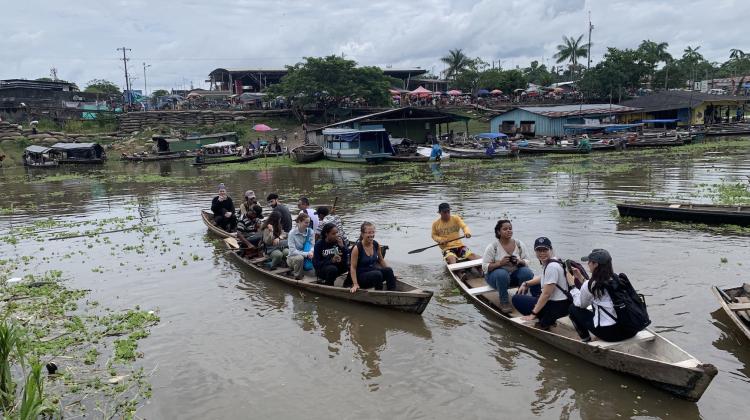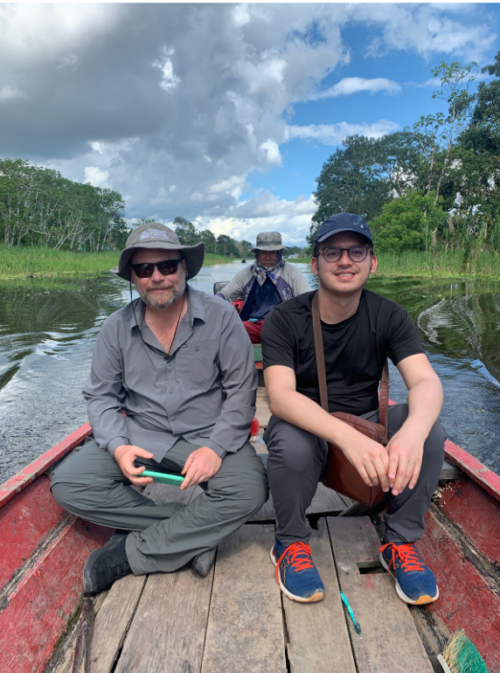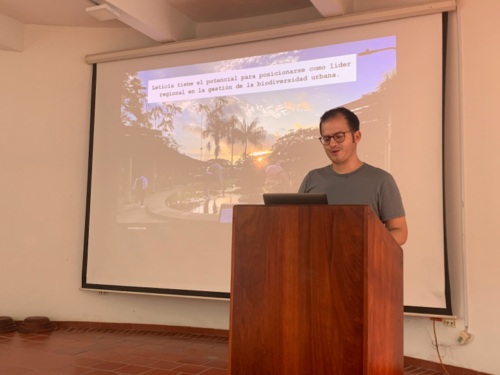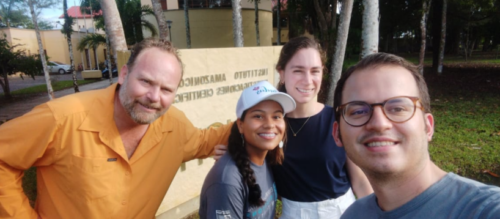Cultivating an Urban, Sustainable Amazonia in Colombia

Leticia — Colombia’s southernmost city in the Amazon — shares a border between Brazil and Peru along the Amazon River. It’s common to hear Portuguese on the streets and eat Peruvian ceviche for lunch.
Due to its strategic location in one of the most biodiverse ecosystems on the planet, and as a strategic natural carbon sink, Leticia was selected as a case study for the DUSP (Department of Urban Studies and Planning) 2023 Spring practicum titled “Biodiversity and Cities: A Perspective in Colombian Cities.”
This course was co-taught between MIT professors Gabriela Carolini and John E. Fernandez, with ESI’s Research Program Director Marcela Ángel, ESI’s Postdoctoral Associate Norhan Bayomi, and PhD candidate Alessandra Fabbri. They worked in partnership with Luz Marina Mantilla, the Director of Colombia’s Amazonian Research Institute SINCHI, and Juan Felipe Guhl, the Director of the Socio-Environmental Dynamics Group at SINCHI.
The research-oriented class centered on improving biodiversity management through urban development strategies for cities participating in Colombia’s Bio-diverse and Resilient Cities Program (formerly known as Biodivercities prior to 2023).
Building on the work of the class, Marco Herndon and Patricia Garcia (both MCP ‘24), dedicated their summers to engaging with stakeholders in Leticia and presenting the recommendations generated during the course, actively contributing to the process of charting the implementation of some of these proposals.
The practicum owes its success to the ongoing partnership with SINCHI, who played a pivotal role as a vital research collaborator of ESI. SINCHI was deeply involved in the design and implementation of the research agenda for the class, instrumental in opening spaces for dialogue with local communities and creating enriching platforms for discussions, and was able to provide valuable insights that enhanced the students’ efforts throughout the semester and the summer fellowship.
A unique, interdisciplinary practicum
Students developed their ideas through a collaborative and multidisciplinary endeavor, with participants hailing from various parts of the world and representing a range of disciplines including architecture, urban planning, and computer science. This mix of disciplines allowed students to balance design proposals with practical, policy recommendations attentive to the idea of Leticia as a single urban system.
To formulate their ideas, the students relied on a multifaceted approach, combining on-the-ground observations from a field-trip conducted in January 2023 with insights drawn from scholarly work conducted by leading researchers on urban biodiversity management.
“The stakeholders in the city were exceptionally open in sharing their experiences and efforts over the years, which inspired our work,” reflected Garcia, with regard to how the practicum provided a unique opportunity to observe diverse perspectives in the urban environment of Leticia.
The students were able to benefit from the profound expertise, extensive knowledge base, and set of strong relationships developed by SINCHI over the past few decades. Through virtual meetings and the exchange of resources, SINCHI laid a robust groundwork for the class, sharing comprehensive insights of Leticia’s urban and biodiversity dynamics, and elucidating potential paths for its future development.
Throughout the semester, students challenged one another to offer both practical and innovative recommendations. They were able to test and validate their ideas through ongoing discussions with SINCHI, which was essential to strengthening them. Their primary focus was on developing strategies that could harness the potential of Leticia’s emerging tourism industry to contribute to biodiversity conservation within a context of local economic development and equity, particularly acknowledging the role of indigenous communities in Leticia and its surrounding areas.
While recognizing their roles as foreign researchers, the class introduced novel ideas that were grounded in the local priorities and the ongoing local initiatives to protect biodiversity. This approach led them to craft a comprehensive set of urban planning strategies that were anchored in three fundamental principles: conservation, inclusion, and feasibility. Some of these strategies included participatory planning, incentivising bioeconomic practices, and urban habitat restoration.
The students further applied their recommendations to envision scenarios for the market and civil port of Leticia, focusing on practical solutions for these areas.

Map of civil port and market area in Leticia. Image credit: Courage Dzidula Kpodo (MIT ‘25)
The market and civil port of Leticia holds cultural and bioeconomic significance, acting as a central hub within the city for the commercialization of indigenous produce. It has the potential to attract tourists with a variety of local food.
The student’s recommendations for this site included:
- Establishing a community-based organization to facilitate participatory planning processes involving food vendors and indigenous producers. Through this approach, community-based ideas for the market plaza’s redesign could be generated, ensuring that the project aligns with the needs and aspirations of the local vendors and indigenous communities who live in the outskirts of Leticia and sell their produce in the market.
- Increasing awareness of the local bio-economy and creating incentives to encourage the adoption of green business practices and the cultivation of a circular economy in the area.
- Ecological landscape restoration to enhance the site’s ecosystem services, including flood mitigation, water filtration, and temperature control, among others.
Further details on the full list of recommendations and potential steps for implementation, as well as a complete diagnostic, are available as a full report.
Following the conclusion of the class, Herndon and Garcia took further steps to ensure its accessibility by translating the final report and executive summary to Spanish.
Returning to Colombia
This past June, Herndon and Ángel returned to Leticia to share the findings of the class. In her capacity as program director and co-instructor, Ángel has fostered a multi-year engagement with key players such as the Ministry of Environment and Sustainable Development of Colombia, as well as SINCHI and the Municipality of Leticia. Through SINCHI, the partners were able to convene with local community groups and other local academic and government actors, facilitating a vital exchange of feedback and insights from stakeholders, which enhanced the depth and breadth of recommendations for the implementation phase.
Starting their visit in Bogotá, Ángel, Herndon, Luz Marina Mantilla (Director of SINCHI), and Juan Felipe Guhl (Director of the Socio-Environmental Dynamics Group at SINCHI), met with The Head of the Bio-diverse and Resilient Cities Program at the Ministry of Environment, Adriana Solano-P., for a fruitful conversation.
Solano-P. stressed the importance of an intervention-based approach, combining bioeconomic strategies with restoration efforts and urban redevelopment plans. She also praised the focus on the market plaza and port area, recognizing its significance as a hub not only for Leticia’s residents, but also for the daily influx of international visitors from Peru and Brazil.
Furthermore, Solano-P emphasized the importance of the national Bio-diverse and Resilient Cities Program, praising the ways that it sought “to re-establish the connection between cities and their natural environments, so urban centers [were] not only tools for social and economic development, but also important spaces for the conservation and the sustainable use of biodiversity.” Looking forward, she added, “Our hope is to incorporate this natural richness into the social and economic development of cities as well as benefit ecological connectivity processes between the urban and the rural to help close gaps.”
Onward to Leticia, the group was joined by Guhl. Guhl, as a thought partner from the inception of the class, provided ample feedback to strengthen the class’ proposal and generously shared his deep expertise about Leticia, its socio-cultural dynamics, and its history of urbanization. Moreover, SINCHI’s well-regarded reputation in Leticia as an effective government actor made it possible for MIT’s researchers to engage in meaningful conversations facilitated by Guhl, who also provided valuable contextual knowledge as well as pragmatic recommendations to make these conversations more fruitful.

Juan Felipe Guhl (SINCHI Institute) and Marco Herndon (MCP’24) on a boat traveling through the Amazon River. Photo credit: Marcela Ángel
During the discussions in Leticia, the group learned that the city had started discussions about renovating the market plaza and port area to improve health and sanitary conditions, making the student’s recommendations warmly welcomed.
As Fernanda Pérez, Municipal Planning Advisor of Leticia, expressed, “We’re very interested in the development of innovative solutions that, acknowledging the socioeconomic reality of the municipality, allow us to advance the development of a bio-sustainable world. We cannot face these challenges alone as a city, and count on support at the national level and through alliances like this one with institutions like MIT.”

Marco Herndon (MCP’24) presents at SINCHI Institute in Leticia, Colombia. Photo credit: Marcela Angel
What stood out the most from these discussions, however, was the evident enthusiasm and interest from the public and key local stakeholders regarding the proposals. The group witnessed how their visit had sparked meaningful conversations about the future of Leticia and a real hope for a more harmonious relationship with the surrounding environment. The participants at the public forum engaged in lively debates, reflecting on the city’s preliminary efforts in redeveloping the market plaza and addressing the complexities of biodiversity conservation. These debates showcased a genuine interest not only to grapple with the students’ ideas and recommendations, but also to collaboratively chart a viable path forward for their implementation.
As Guhl observed, the visit was a rare opportunity for a university to “engage in timely and on-going conversations with a robust framework and specific ideas.”

Team members gather. From left to right: Juan Felipe Guhl (SINCHI Institute), Maylin Martinez (a local high school student in Leticia), Marcela Ángel (ESI Research Program Director), and Marco Herndon (MCP’24). Photo credit: Marco Herndon
At the end of their visit, Ángel, Herndon, and Guhl took a brief trip to the Yahuarkaka Lakes.
“A journey along the water just minutes away from the city is a powerful reminder of what’s at stake in finding new pathways for urban development for cities in biodiversity hotspots, and in the case of Leticia, to protect the Amazon’s cultural and biological diversity,” commented Ángel, while the group traveled by riverboat through rain and blazing sunlight, observing the wide array of birds, trees, and human settlements patterns unique to that part of the Amazon.
Learn more and access the final reports in both Spanish and English


